An Updated Technical–Tactical Categorisation in Taekwondo: From General Tactical Objectives to Combat Situations
Abstract
:1. Introduction
2. Materials and Methods
2.1. The Design of Technical–Tactical Categorisation
2.2. Technical–Tactical Categorisation Validation
3. Results
3.1. The Design of Technical–Tactical Categorisation
3.2. Technical–Tactical Observational Tool Validation and Preliminary Results
4. Discussion
5. Conclusions
Author Contributions
Funding
Institutional Review Board Statement
Informed Consent Statement
Conflicts of Interest
References
- Moening, U. La evolución de las técnicas de patada en taekwond. Rev. Artes Marciales Asiat. 2011, 6, 117–140. [Google Scholar] [CrossRef] [Green Version]
- Matveyev, L. Fundamentals of Sports Training; Progress Publishers: Moscow, Russia, 1981. [Google Scholar]
- Hernández Moreno, J. Fundamentos del Deporte: Análisis de las Estructuras del Juego Deportivo, 4th ed.; INDE Publicaciones: Barcelona, Spain, 1994. [Google Scholar]
- Parlebas, P. Léxico de Praxiología Motriz; Paidotribo: Badalona, Spain, 2001. [Google Scholar]
- Menescardi, C.; Ruiz Sanchis, L.; Estevan, I.; Falco, C. Uma atualização da lógica interna de competição do combate no taekwondo. Movimento 2020, 26, e26038. [Google Scholar] [CrossRef]
- Azuma, R.; Daily, M.; Furmanski, C. A Review of Time Critical Decision Making Models and Human Cognitive Processes. IEEEAC Paper #1650. 2005. Available online: http://www.cs.unc.edu/~azuma/aerospace06_final.pdf (accessed on 25 November 2020).
- Benito Díez, J. and Barrientos Varela, M. Taekwondo: Técnica, Táctica, Estrategia, Competición; Paidotribo: Badalona, Spain, 2020. [Google Scholar]
- World Taekwondo Federation. Competition Rules & Interpretation. 2019. Available online: http://www.worldtaekwondo.org/wp-content/uploads/2019/08/WT-Competition-Rules-Interpretation-Manchester-May-15-2019.pdf (accessed on 25 November 2020).
- Ruiz-Sanchís, L.; Ros-Ros, C.; Bastida-Torróntegui, A.I. Esgrima en silla de ruedas, propuesta para su inclusión en el contexto escolar/Wheelchair fencing, proposal for its inclusion in the school context. Ágora para la Educación Física y el Deporte 2016, 18, 61–76. [Google Scholar]
- Ortega-Toro, E.; García-Angulo, A.; Giménez-Egido, J.M.; García-Angulo, F.J.; Palao, J.M. Design, validation, and reliability of an observation instrument for technical and tactical actions of the offense phase in soccer. Front. Psychol. 2019, 24, 22. [Google Scholar] [CrossRef] [PubMed] [Green Version]
- Menescardi, C.; Falco, C.; Hernández-Mendo, A.; Morales-Sánchez, V. Design, validation, and testing of an observational tool for technical and tactical analysis in the taekwondo competition at the 2016 Olympic games. Physiol. Behav. 2020, 224, 112980. [Google Scholar] [CrossRef] [PubMed]
- Hernández-Mendo, A.; Blanco-Villaseñor, A.; Pastrana, J.L.; Morales-Sánchez, V.; Ramos-Pérez, F.J. SAGT: Aplicación informática para análisis de generalizabilidad. Revista Iberoamericana de Psicología del Ejercicio y el Deporte 2016, 11, 77–89. [Google Scholar]
- Falcó Pérez, C. Estudio Sobre Parámetros Mecánicos y Distancia de Golpeo de Bandal Chagui de Taekwondo. Ph.D. Thesis, University of València, Valencia, Spain, 2009. [Google Scholar]
- Moenig, U.; Cho, S.; Song, H. The modifications of protective gear, rules and regulations during taekwondo’s evolution—From its obscure origins to the Olympics. Int. J. Hist. Sport 2012, 29, 1363–1381. [Google Scholar] [CrossRef]
- Menescardi, C.; Falcó, C.; Hernández-Mendo, A.; Morales-Sánchez, V. Analysis of different key behavioral patterns to score in elite Taekwondoists according to the weight category and gender. Front. Psychol. 2021, 12, 713869. [Google Scholar] [CrossRef]
- Ramazanoglu, N. Transmission of impact through the electronic body protector in taekwondo. Int. J. Appl. Sci. Technol. 2013, 3, 1–7. [Google Scholar]
- Falco, C.; Landeo, R.; Menescardi, C.; Bermejo, J.L.; Estevan, I. Match analysis in a university taekwondo championship. Adv. Phys. Ed. 2012, 2, 28–31. [Google Scholar] [CrossRef] [Green Version]
- Kazemi, M.; Waalen, J.; Morgan, C.; White, A.R. A profile of olympic Taekwondo competitors. J. Sports Sci. Med. 2006, 5, 114. [Google Scholar]
- De la Fuente García, A.; Castejón Oliva, F.J. Análisis del combate en taekwondo:categorías para la evaluación de las acciones tácticas;estudio preliminar/An evaluation of categories for tactical actions: A preliminary study of combat analysis in Taekwondo. Cult. Cienc. Deporte 2016, 11, 157–170. [Google Scholar] [CrossRef] [Green Version]
- Oliva Seba, A.; Torres Baena, F.T.; Navarro Mouchet, J. Combate Supremo; Club Karate Musoken: Tarragona, Spain, 2002. [Google Scholar]
- Menescardi Royuela, C.; Moya-Mata, I.; Ros Ros, C.; Estevan, I. Análisis del tiempo de lucha y no lucha en taekwondistas cadetes/Fighting and non-fighting time-motion in Taekwondo cadet athletes. Sportis 2016, 2, 164–176. [Google Scholar] [CrossRef] [Green Version]
- Del Vecchio, F.B.; Franchini, E.; Del Vecchio, A.H.M.; Pieter, W. Energy absorbed by electronic body protectors from kicks in a taekwondo competition. Biol. Sport 2011, 28, 75–78. [Google Scholar] [CrossRef] [Green Version]
- Ramazanoglu, N. Effectiveness of protective foot and forearm guards in Taekwondo. Arch. Budo 2012, 8, 207–211. [Google Scholar] [CrossRef]
- Leveaux, R. 2012 Olympic Games Decision Making Technologies for Taekwondo Competition. Commun. IBIMA 2020, 2012, 1. [Google Scholar] [CrossRef]
- Kruszewski, A.; Kúzmicki, S.; Podchul, A.; Kruszewski, M. Effect of changes in the sports regulations on the fight of Taekwondo female players on the example of Beijing Olympic Tournaments 2008 and London 2012. J. Combat. Sports Martial Arts 2014, 5, 97–100. [Google Scholar] [CrossRef] [Green Version]
- Moenig, U. Martial arts versus martial sports. In Proceedings of the 1st International Conference for World Martial Arts Masterships, Chungju, Korea, 25 August 2015. [Google Scholar]
- Pyciarz, T. Analysis of sport fight structure in Taekwondo during the Olympics in Beijing in 2008 and Senior World Championships in 2009 in terms of technical skills after regulation amendments and implementation of the electronic system of score recording. J. Combat. Sports Martial Arts 2011, 2, 109–115. [Google Scholar] [CrossRef] [Green Version]
- Estevan, I.; Álvarez, O.; Falco, C.; Molina-García, J.; Castillo, I. Impact force and time analysis influenced by execution distance in a roundhouse kick to the head in Taekwondo. J. Strength Cond. Res. 2011, 25, 2851–2856. [Google Scholar] [CrossRef]
- Menescardi, C.; Falco, C.; Estevan, I.; Ros, C.; Morales-Sánchez, V.; Hernández-Mendo, A. Is it possible to predict an athlete’s behavior? The use of polar coordinates to identify key patterns in Taekwondo. Front. Psychol. 2019, 10, 1232. [Google Scholar] [CrossRef]
- Menescardi, C.; Falco, C.; Ros, C.; Morales-Sánchez, V.; Hernández-Mendo, A. Development of a Taekwondo combat model based on Markov analysis. Front. Psychol. 2019, 10, 2188. [Google Scholar] [CrossRef]
- Williams, A.M.; Davids, K.; Williams, J.G. Visual Perception and Action in Sport; E & F.N.Spon: London, UK, 1999. [Google Scholar]
- Kruszewski, A.; Jagiełło, W.; Pytel, W. The Effectiveness of Used Techniques in a Taekwondo Fight in the Olympic Tournament in Sydney 2000 and Athens 2004. Wellness and Prosperity in Different Phases of Life; Olchowik, G., Ed.; Wydawnictwo NeuroCentrum: Lublin, Poland, 2009; pp. 197–211. [Google Scholar]
- Mirallas Sariola, J.A. El Movimiento Deportivo: Teoría General; Ergon: Barcelona, Spain, 2007. [Google Scholar]
- Anguera Argilaga, M.T.; Blanco Villaseñor, A.; Losada, J.L. Diseños observacionales, cuestión clave en el proceso de la metodología observacional. Metodol. Cienc. Comport. 2001, 3, 135–160. [Google Scholar]
- Sampedro, J. La inteligencia motriz deportiva:el pensamiento táctico y el proceso de entrenamiento. Gac. Gymnos 2000, 5, 4–8. [Google Scholar]
- González de Prado, C.; Iglesias y Reig, X.; Miralles Sariola, J.A.; Esparza Pérez, G. Sistematización de la acción táctica en el Taekwondo de alta competición/Systematization of tactical action in high-level competition Taekwondo. Apunts Educación Física y Deportes 2011, 103, 56–67. [Google Scholar]
- Cardinali, D.P. Neurociencia Aplicada: Sus Fundamentos; Editorial Médica Panamericana: Buenos Aires, Argentina, 2007. [Google Scholar]
- Matsushigue, K.A.; Hartmann, K.; Franchini, E. Taekwondo: Physiological responses and match analysis. J. Strength Cond. Res. 2009, 23, 1112–1117. [Google Scholar] [CrossRef]
- Kazemi, M.; Perri, G.; Soave, D. A profile of 2008 olympic Taekwondo competitors. J. Can. Chiropr. Assoc. 2010, 54, 243. [Google Scholar]
- Menescardi, C.; Estevan, I.; Ros, C.; Hernández-Mendo, A.; Falco, C. Bivariate analysis of Taekwondo actions: The effectiveness of techniques and tactics in an olympic Taekwondo championship. J. Hum. Sport Exerc. 2021, 16, 199–211. [Google Scholar] [CrossRef]
- Tabben, M.; Miarka, B.; Chamari, K.; Beneke, R. Decisivemoment: A metric to determine success in elite karate bouts. Int. J. Sports Physiol. Perform. 2018, 13, 1000–1004. [Google Scholar] [CrossRef] [PubMed]
- Tornello, F.; Capranica, L.; Chiodo, S.; Minganti, C.; Tessitore, A. Time motion analysis of youth olympic Taekwondo combats. J. Strength Cond. Res. 2013, 27, 223–228. [Google Scholar] [CrossRef] [PubMed]
- Santos, V.G.; Franchini, E.; Lima-Silva, A.E. Relationship between attack and skipping in Taekwondo contests. J. Strength Cond. Res. 2011, 25, 1743–1751. [Google Scholar] [CrossRef] [PubMed]
- Bridge, C.A.; Jones, M.A.; Drust, B. The activity profile in international Taekwondo competition is modulated by weight category. Int. J. Sports Physiol. Perform. 2011, 6, 344–357. [Google Scholar] [CrossRef] [PubMed] [Green Version]
- López-López, J.A.; Menescardi, C.; Estevan, I.; Falcó, C.; Hernández-Mendo, A. Análisis técnico-táctico en Taekwondo con coordenadas polares a través del software HOISAN/Technical-tactical analysis in Taekwondo with polar coordinates through software HOISAN. Cuad. Psicol. Deport. 2015, 15, 131–142. [Google Scholar] [CrossRef] [Green Version]
- Casolino, E.; Lupo, C.; Cortis, C.; Chiodo, S.; Minganti, C.; Capranica, L.; Tessitore, A. Technical and tactical analysis of youth Taekwondo performance. J. Strength Cond. Res. 2012, 26, 1489–1495. [Google Scholar] [CrossRef] [PubMed]
- Iglesias, X.; Gasset, A.; González, C.; Anguera, M.T. Interacción competitiva y presión ambiental en deportes de combate: Aplicación de la metodología observacional. Rev. Iberoam. Psicol. Ejerc. Deporte 2010, 5, 267–282. [Google Scholar]
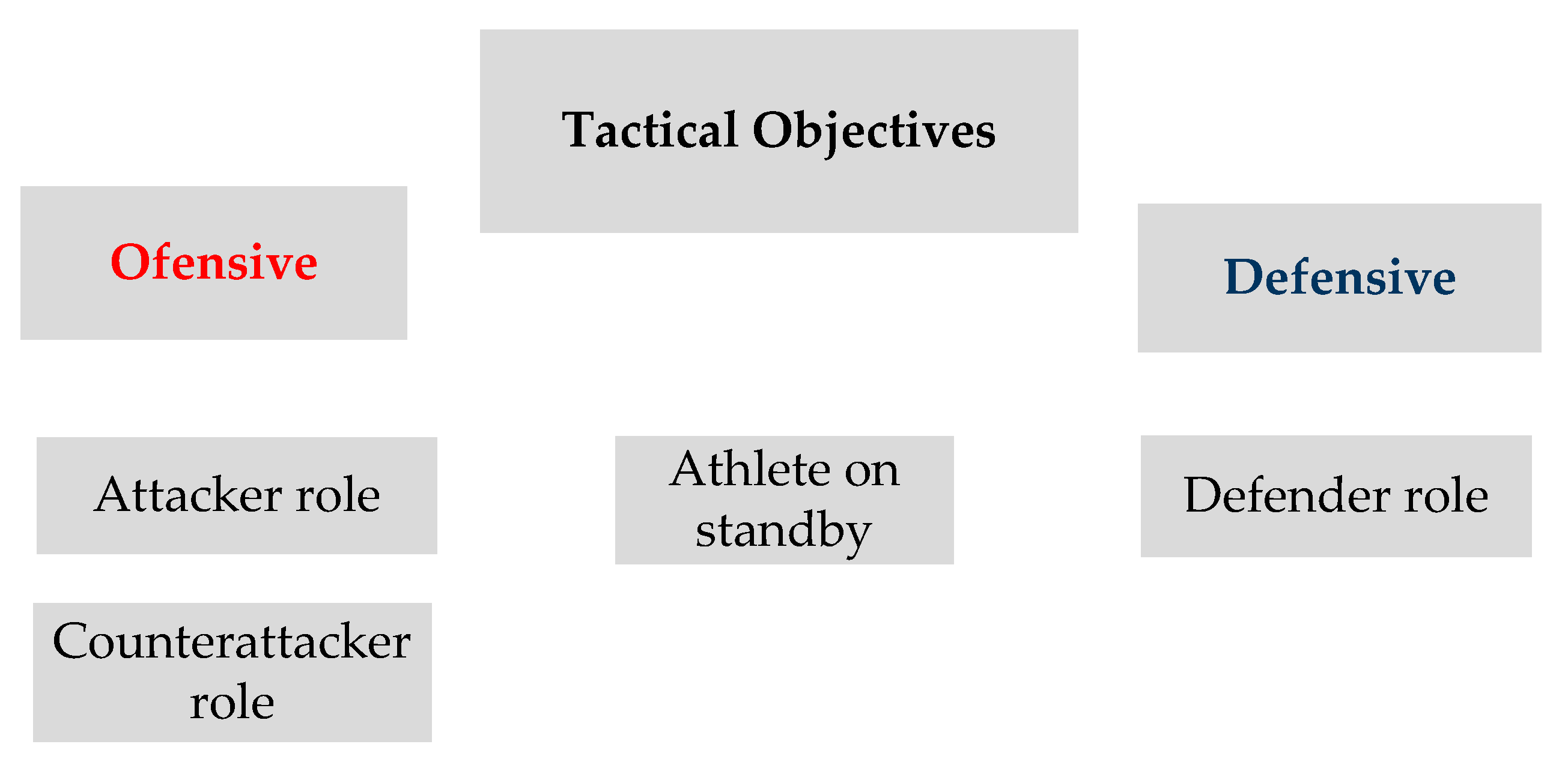
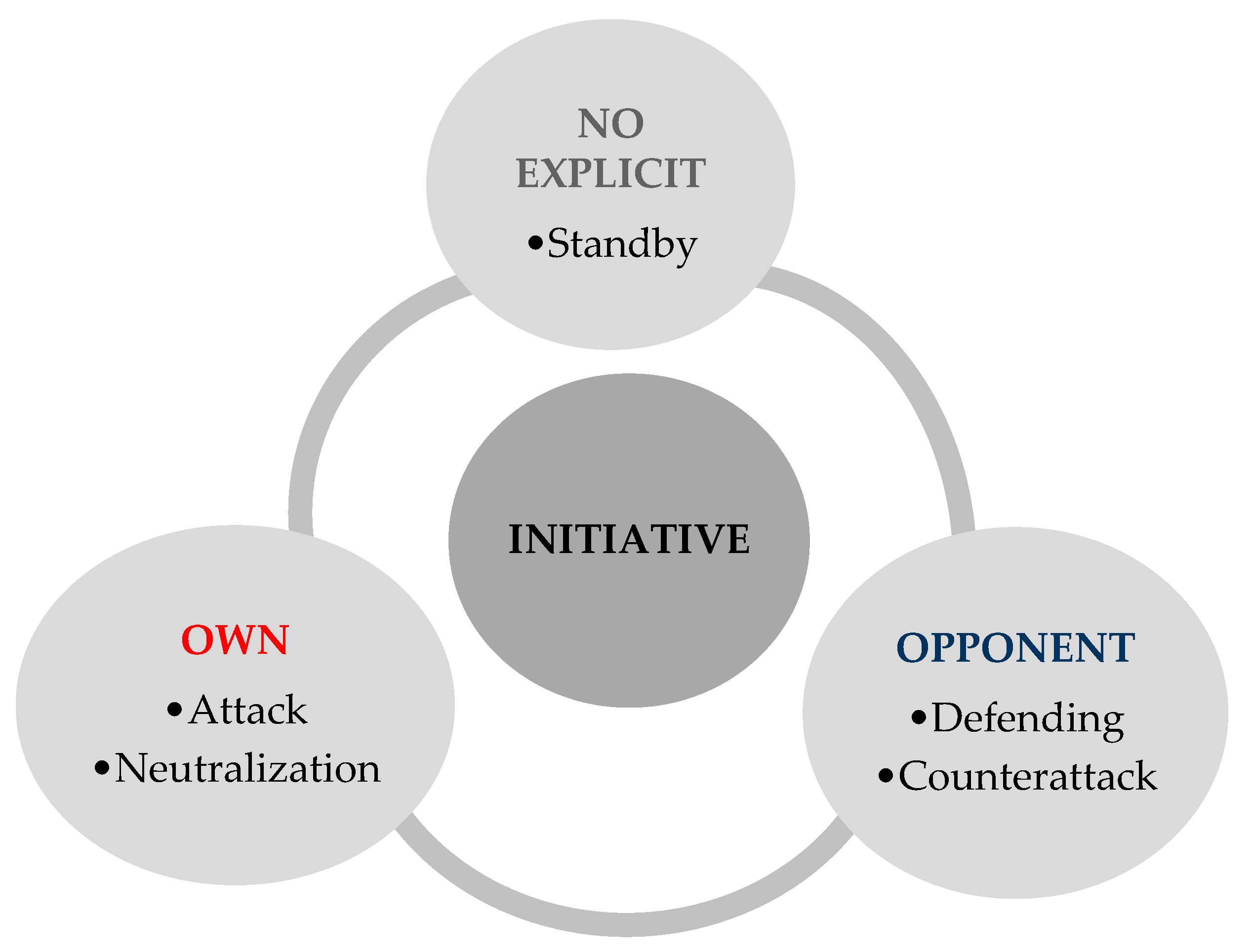
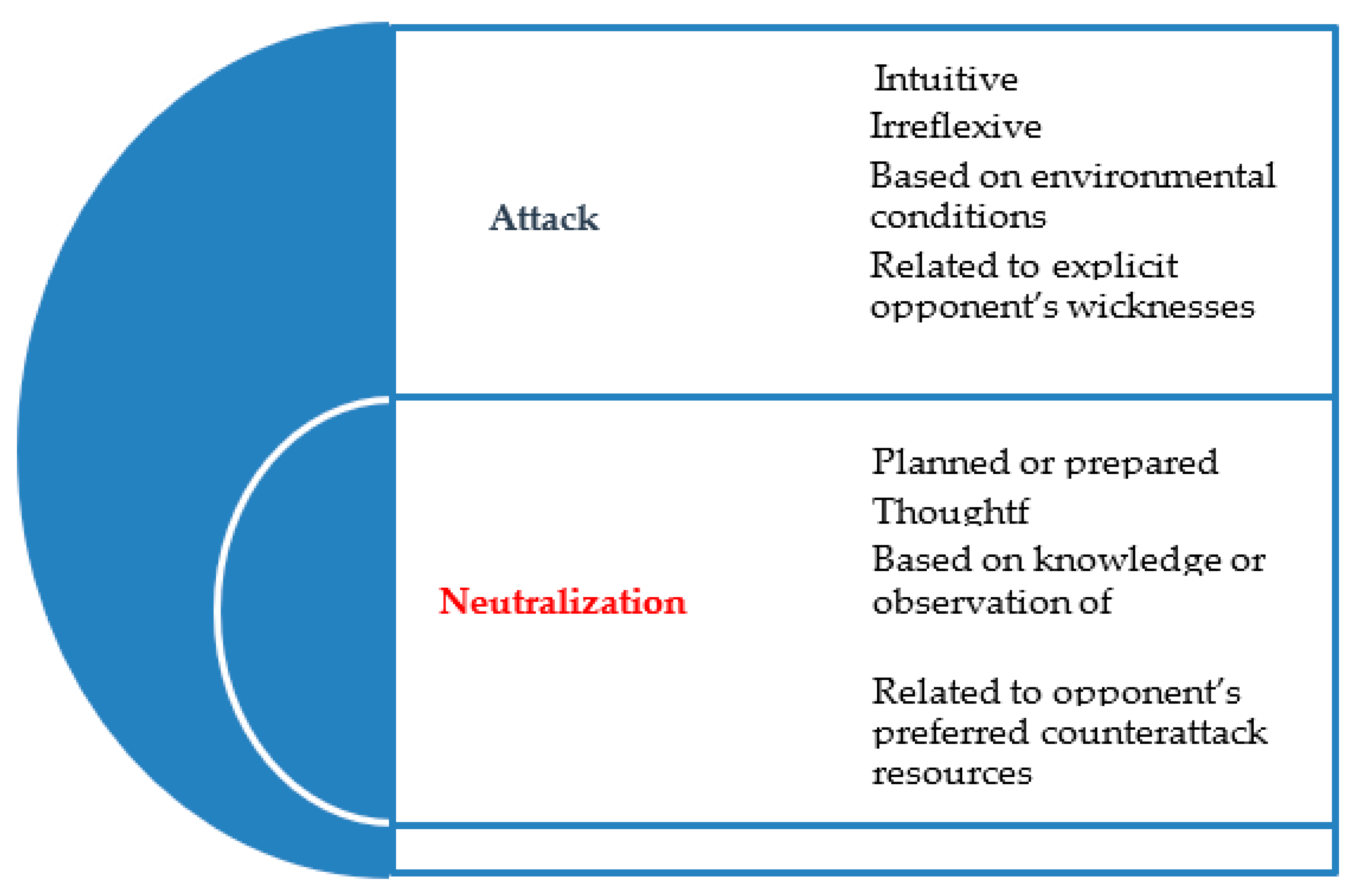
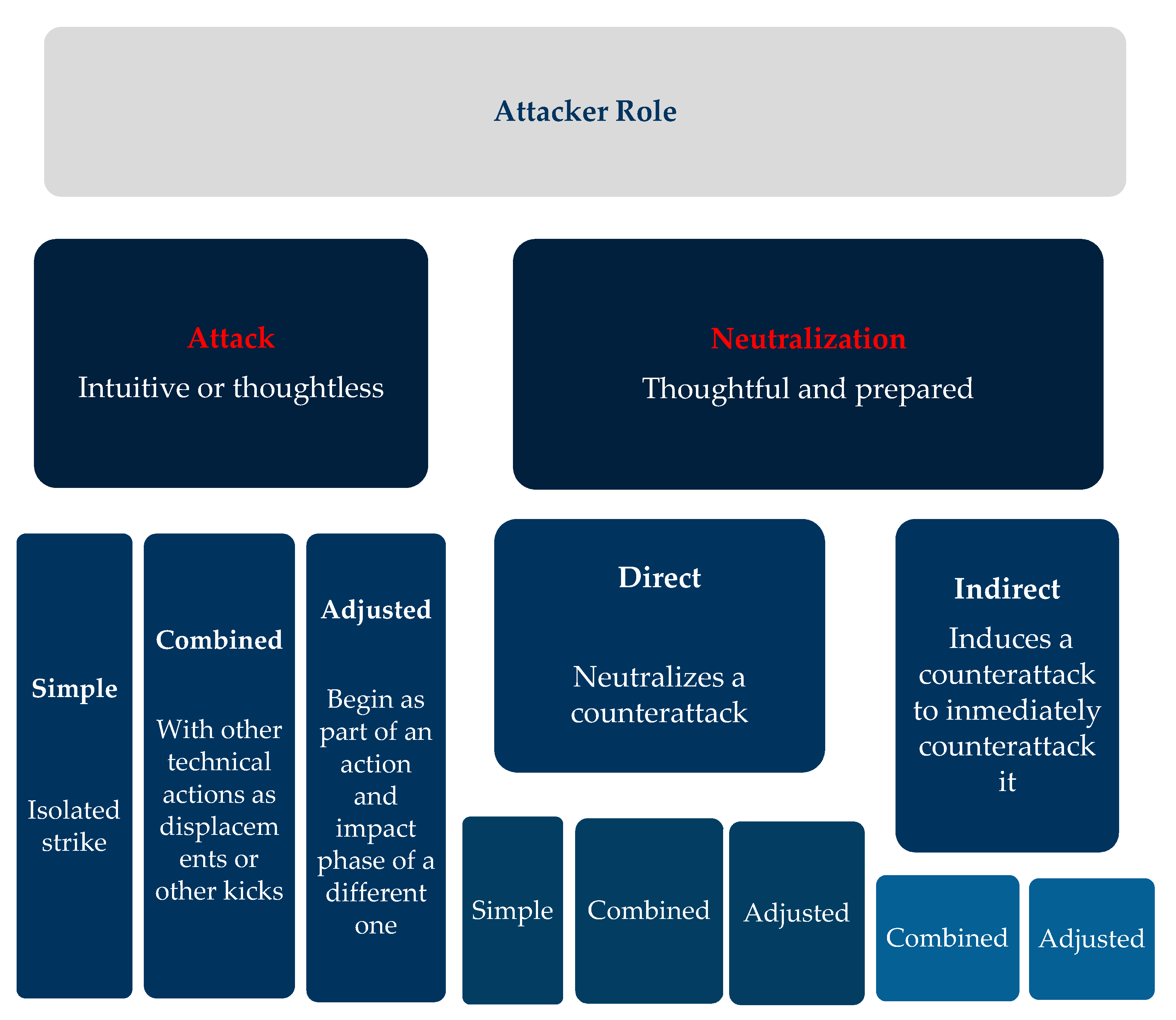
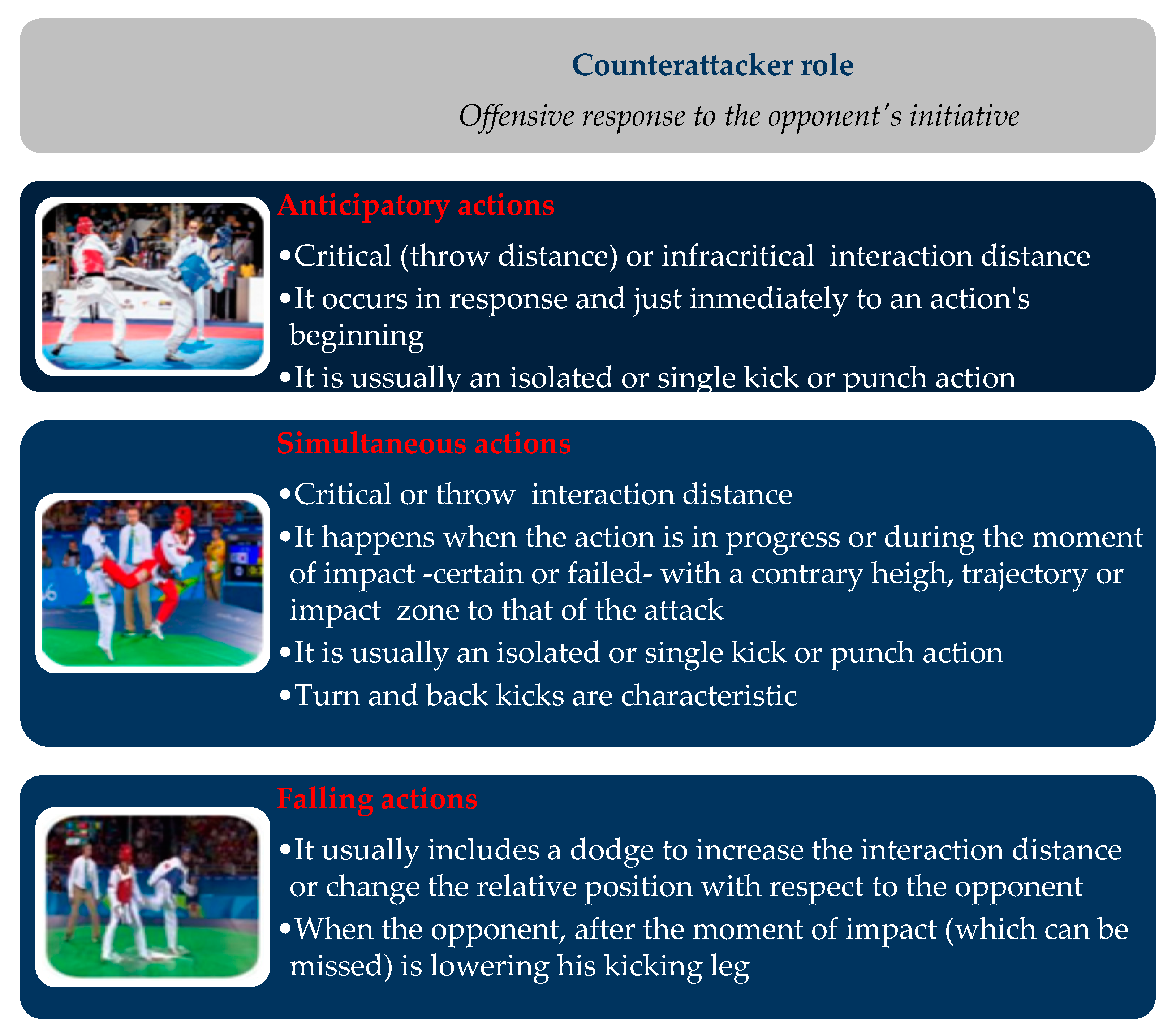
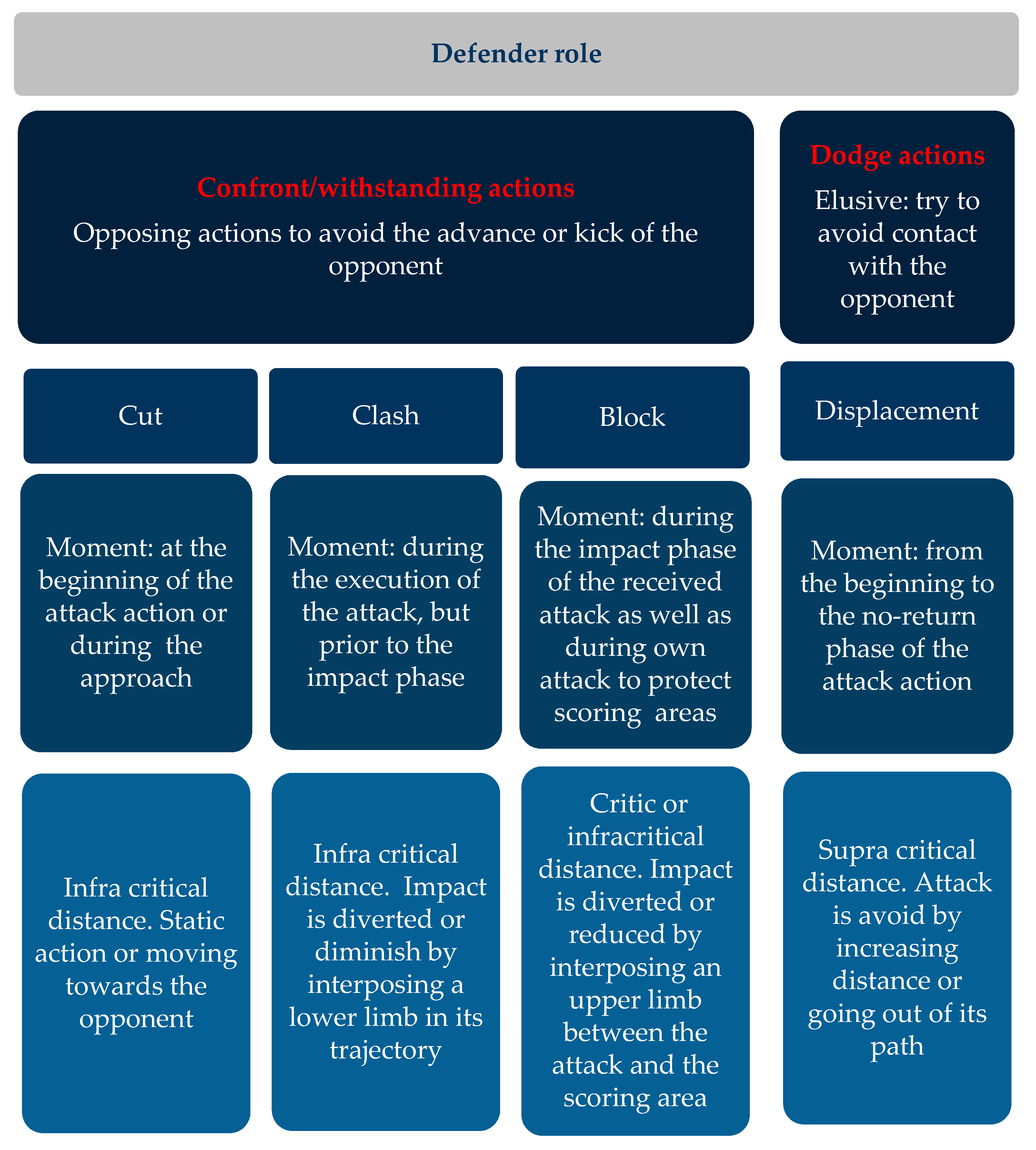
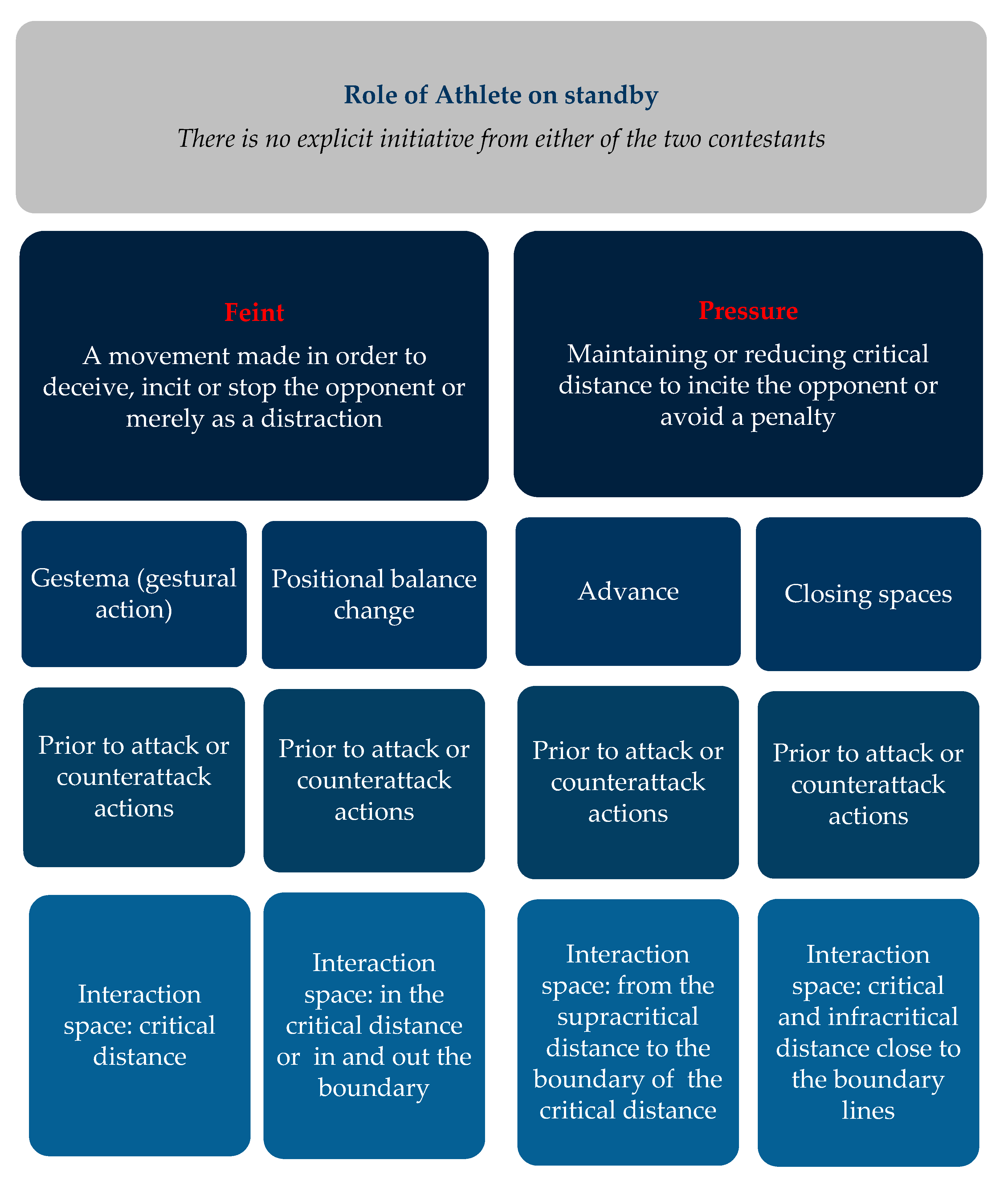
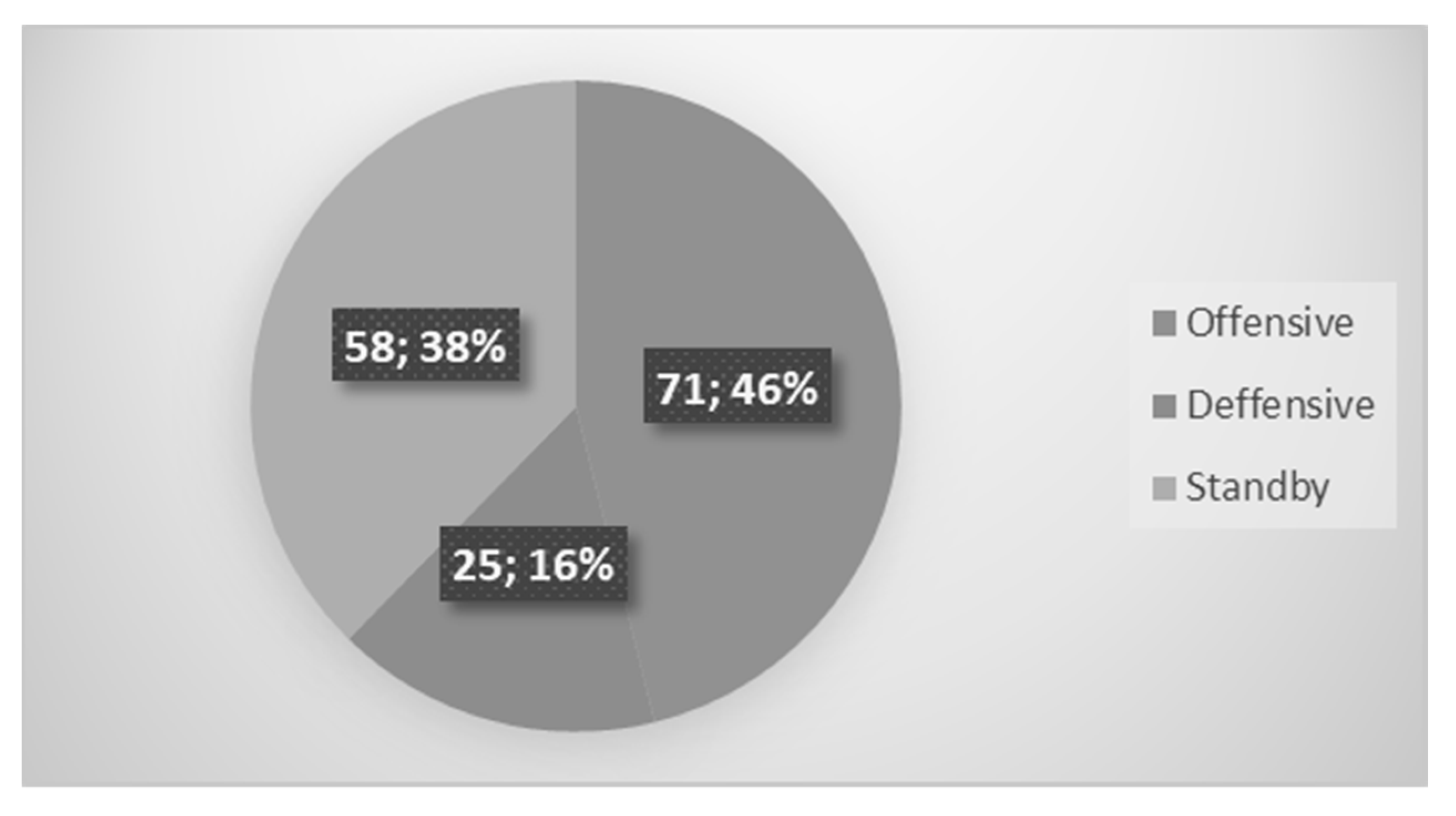
| Established Criteria for the Election of Expert Advisors: | |
|---|---|
| 1 | International taekwondo trainers and coaches with World Taekwondo Federation accreditation licence. |
| 2 | Having participated as coaches in recently celebrated International Official Championships. |
| 3 | Having trained athletes included in the World Taekwondo Federation Olympic Rankings. |
| Phases in the Production of the Consensus Document: | |
|---|---|
| 1 | Theoretical–scientific and technical bibliography review. |
| 2 | Main tactical objectives determination. |
| 3 | Definition of the roles which contestants can adopt according to each tactical objective and the parameter ‘initiative’. |
| 4 | Construction of the ‘technical–tactical resource’ concept by the association of the objectives, roles, and technical elements. |
| 5 | Establishment of the parameters that affect the election of technical–tactical resources: the environmental factors. |
| 6 | Synthesis of the concept of ‘contest situation’ and determination of the factors that condition it. |
| Criteria | Category | Data Measurement |
|---|---|---|
| Context | Event: | Name |
| Contest number | Nº | |
| Gender | Male/female | |
| Weight | −58/−68/−80/+80/−49/−57/−67/+67 | |
| Phase | 1ST/2ND/3RD/4TH/5TH/semifinal/final/repechage n | |
| Pss colour | Blue/red | |
| Competitor | Contestant/competitor | Blue/red (or name) |
| Weight | Kg | |
| Heigh | (cm) | |
| Legs length/leg reach | (cm) | |
| Contest situation characteristics | Order of the contest situation | Number |
| Start | (s from the beginning) | |
| End | (s from the beginning) | |
| Duration | (ms) | |
| Remaining time | (s to the end) | |
| Decisive moment (irreversible advantage) | Yes/no | |
| Space (on the mat) | Centre(4 × 4)/surrounding/boundary line | |
| Interaction distance | Infra-critical/crítical/supra-critical/clinch | |
| Scoring interaction result | +n/0/−n | |
| Technical–tactical resource characteristics | Initiative | Own/opponent/stand by |
| Role | Attacker/counterattacker/defender/no explicit | |
| Technical–tactical action | Attack/neutralisation/anticipation/simultaneous/falling/confront/dodge/feint/pressure | |
| Action subtype | Direct/indirect/cut/clash/block/displacement/gestema/positional change/advance/closing spaces | |
| Complexity | Simple/combined/adjusted | |
| Technical–tactical resource | Specific denomination | |
| Concluding event | Score/point-gap/pause/takedown/time limit/exit/clinch/incident or accident | |
| Effectiveness | Effectiveness/outcome | Positive/negative (respect to the tactical objective) |
| Misadjustments (if negative) | Spatial/temporal/technical/decisional/random | |
| Relative effectiveness | Scoring difference after the situation ends | |
| Scoreboard | X–Y | |
| External influences | Coach/judges/referee/instant video-replay claim |
| Distance | Definition |
|---|---|
| Critical | The contestants are within reach of a single strike of the opponent. |
| Supra-critical | Contestants cannot be reached by performing a single kick action. The combination of several kicks or the association with displacements is required. |
| Infra-critical | Contestants are too close to be kicked by a single or combined kicking action. |
| Melee or clinch | The space between the two contestants, who are in contact, disappears. |
| Counterattack Subtype | Execution Moment |
|---|---|
| Anticipatory actions | When the opponent is initiating action and therefore entering the critical distance. |
| Simultaneous actions | When the action is in progress, and the performer is in a situation of inertia that prevents them from rectifying their action. |
| Falling or subsequent actions | When the opponent, after the moment of impact (which can be missed) is lowering their kicking leg, still in a situation of instability, as they are on a single support. |
| G Study | D Study | ||||||
|---|---|---|---|---|---|---|---|
| Sources of Variation | Sum of Squares (Type III) | df | R1 | R2 | R3 | R4 | |
| [o] | 0.031 | 2 | [o] | (3; inf) | (3; inf) | (3; inf) | (3; inf) |
| [c] | 456.671 | 16 | [c] | (17; inf) | (17; inf) | (17; inf) | (17; inf) |
| [o][c] | 2.809 | 32 | [b] | (5; inf) | (10; inf) | (15; inf) | (20; inf) |
| [b] | 541.8 | 4 | N observ. | 255 | 510 | 765 | 1020 |
| [o][b] | 0.211 | 8 | G coeff. | 0.557 | 0.715 | 0.79 | 0.834 |
| [c][b] | 810.746 | 64 | Error | 0.849 | 0.424 | 0.283 | 0.212 |
| [o][c][b] | 4.122 | 128 | SD error | 0.921 | 0.651 | 0.532 | 0.461 |
| Offensive | Defensive | Both | Proper | Adversary | Standby | Attacks | Counter Attacks | Defence | |
|---|---|---|---|---|---|---|---|---|---|
| Beijing 2008 | 40.00 | 20.00 | 40.00 | 20.00 | 40.00 | 40.00 | 20.00 | 20.00 | 20.00 |
| London 2012 | 45.71 | 11.43 | 42.86 | 31.43 | 25.71 | 42.86 | 31.43 | 14.29 | 11.43 |
| GP Manchester 2014 | 70.59 | 11.76 | 17.65 | 29.41 | 17.65 | 52.94 | 17.65 | 11.76 | |
| Rio de Janeiro 2016 | 42.27 | 18.56 | 39.18 | 34.02 | 26.80 | 39.18 | 34.02 | 8.25 | 18.56 |
| Simple | Comb. | Correct. | Direct. | Indirect. | Anticipat. | Simult. | Subseq. | |
| Beijing 2008 | 20.00 | 0.00 | 0.00 | 0.00 | 0.00 | 0.00 | 0.00 | 20.00 |
| London 2012 | 8.57 | 0.00 | 0.00 | 14.29 | 8.57 | 11.43 | 2.86 | 0.00 |
| GP Manchester 2014 | 41.18 | 0.00 | 11.76 | 0.00 | 0.00 | 5.88 | 11.76 | 0.00 |
| Rio de Janeiro 2016 | 9.28 | 11.34 | 2.06 | 4.12 | 7.22 | 5.15 | 3.09 | 0.00 |
| Cut | Clash | Block | Displac. | Feint | Posit. Change | Advance | Closing Spaces | |
| Beijing 2008 | 0.00 | 0.00 | 0.00 | 20.00 | 0.00 | 0.00 | 20.00 | 20.00 |
| London 2012 | 11.43 | 0.00 | 0.00 | 0.00 | 2.86 | 8.57 | 28.57 | 2.86 |
| GP Manchester 2014 | 5.88 | 0.00 | 0.00 | 5.88 | 0.00 | 0.00 | 11.76 | 5.88 |
| Rio de Janeiro 2016 | 4.12 | 4.12 | 4.12 | 6.19 | 5.15 | 2.06 | 21.65 | 10.31 |
Publisher’s Note: MDPI stays neutral with regard to jurisdictional claims in published maps and institutional affiliations. |
© 2021 by the authors. Licensee MDPI, Basel, Switzerland. This article is an open access article distributed under the terms and conditions of the Creative Commons Attribution (CC BY) license (https://creativecommons.org/licenses/by/4.0/).
Share and Cite
Barrientos, M.; Saavedra-García, M.A.; Arriaza-Loureda, R.; Menescardi, C.; Fernández-Romero, J.J. An Updated Technical–Tactical Categorisation in Taekwondo: From General Tactical Objectives to Combat Situations. Sustainability 2021, 13, 10493. https://doi.org/10.3390/su131910493
Barrientos M, Saavedra-García MA, Arriaza-Loureda R, Menescardi C, Fernández-Romero JJ. An Updated Technical–Tactical Categorisation in Taekwondo: From General Tactical Objectives to Combat Situations. Sustainability. 2021; 13(19):10493. https://doi.org/10.3390/su131910493
Chicago/Turabian StyleBarrientos, Merce, Miguel A. Saavedra-García, Rafael Arriaza-Loureda, Cristina Menescardi, and Juan J. Fernández-Romero. 2021. "An Updated Technical–Tactical Categorisation in Taekwondo: From General Tactical Objectives to Combat Situations" Sustainability 13, no. 19: 10493. https://doi.org/10.3390/su131910493
APA StyleBarrientos, M., Saavedra-García, M. A., Arriaza-Loureda, R., Menescardi, C., & Fernández-Romero, J. J. (2021). An Updated Technical–Tactical Categorisation in Taekwondo: From General Tactical Objectives to Combat Situations. Sustainability, 13(19), 10493. https://doi.org/10.3390/su131910493






